Pentium 4 3.46 Extreme Edition and 925XE: 1066MHz FSB Support is Here
by Anand Lal Shimpi on October 31, 2004 3:00 PM EST- Posted in
- CPUs
Business/General Use Performance
Business Winstone 2004
Business Winstone 2004 tests the following applications in various usage scenarios:
. Microsoft Access 2002
. Microsoft Excel 2002
. Microsoft FrontPage 2002
. Microsoft Outlook 2002
. Microsoft PowerPoint 2002
. Microsoft Project 2002
. Microsoft Word 2002
. Norton AntiVirus Professional Edition 2003
. WinZip 8.1
We saw in our initial benchmarks that the 1066MHz FSB does very little for business applications, thus it's no surprise here to see the 3.46EE barely outperform its 3.4GHz counterpart.

Office Productivity SYSMark 2004
SYSMark's Office Productivity suite consists of three tests, the first of which is the Communication test. The Communication test consists of the following:
"The user receives an email in Outlook 2002 that contains a collection of documents in a zip file. The user reviews his email and updates his calendar while VirusScan 7.0 scans the system. The corporate web site is viewed in Internet Explorer 6.0. Finally, Internet Explorer is used to look at samples of the web pages and documents created during the scenario."
Similar to what we just saw in the Business Winstone tests, the 3.46EE doesn't change things for Intel here. The 3.46EE is about the same speed as the Pentium 4 550 and the older 3.4EE.
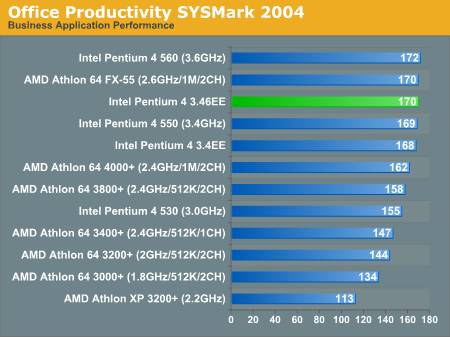
The next test is Document Creation performance, which shows very little difference in drive performance between the contenders:
"The user edits the document using Word 2002. He transcribes an audio file into a document using Dragon NaturallySpeaking 6. Once the document has all the necessary pieces in place, the user changes it into a portable format for easy and secure distribution using Acrobat 5.0.5. The user creates a marketing presentation in PowerPoint 2002 and adds elements to a slide show template."
The extra speed and the faster FSB gives Intel the right to the top bar, but performance remains virtually unchanged from the pre-3.46EE days.

The final test in our Office Productivity suite is Data Analysis, which BAPCo describes as:
The 3.46EE does a little better here, climbing up one spot to outperform the Pentium 4 530, but still falling behind the Pentium 4 550."The user opens a database using Access 2002 and runs some queries. A collection of documents are archived using WinZip 8.1. The queries' results are imported into a spreadsheet using Excel 2002 and are used to generate graphical charts."
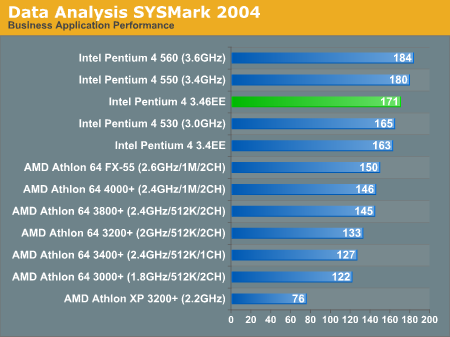
Microsoft Office XP SP-2
Here we see in that the purest of office application tests, performance doesn't vary all too much. The spread of performance here is around 6%, which is nothing terribly significant. While AMD continues to top the charts, Intel is basically on par with them here.
There's no performance difference here between the 3.46EE and the 3.4EE:
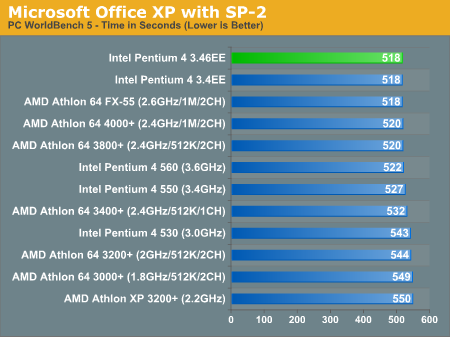
Mozilla 1.4
Quite possibly the most frequently used application on any desktop is the one we pay the least amount of attention to when it comes to performance. While a bit older than the core that is now used in Firefox, performance in Mozilla is worth looking at as many users are switching from IE to a much more capable browser on the PC - Firefox.
The faster FSB improves performance a bit here but it is still not enough to dethrone AMD, the 3.46EE performs similar to an Athlon 64 3000+. 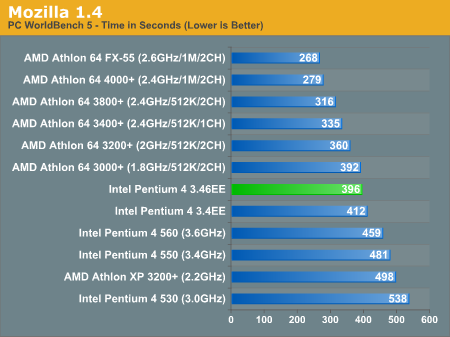
ACD Systems ACDSee PowerPack 5.0
ACDSee is a popular image editing tool that is great for basic image editing options such as batch resizing, rotating, cropping and other such features that are too elementary to justify purchasing something as powerful as Photoshop for. There are no extremely complex filters here, just pure batch image processing.

Ahead Software Nero Express 6.0.0.3
While it was a major issue in the past, these days buffer underrun errors while burning a CD or DVD are few and far between thanks to high performance CPUs as well as vastly improved optical drives. When you take the optical drive out of the equation, how do these CPU's stack up with burning performance?
As you'd guess, they're all pretty much the same, with the slight variations between chips falling within expectations. Any of these chips will do just fine. The 3.46EE is just as fast as its predecessor.
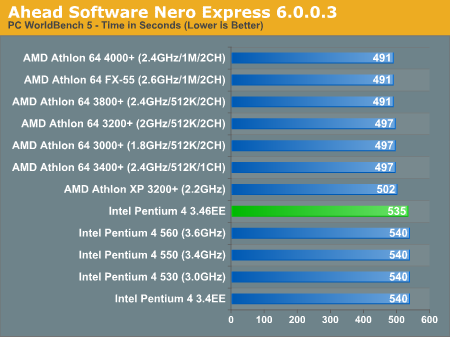
Winzip
Archiving performance ends up being fairly CPU bound as well as I/O limited. The faster FSB and slightly higher clock speed give the 3.46EE a slight advantage over the 3.4EE, but nothing noticeable. On the charts it puts Intel within finger's reach of AMD.
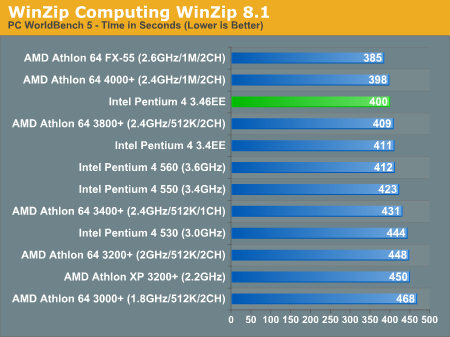
WinRAR 3.40
Pulling the hard disk out of the equation we can get a much better idea of which processors are truly best suited for file compression. While the hard drive hid a lot of the shortcomings of the Athlon XP in WorldBench's WinZip test, they are all revealed in WinRAR's built in benchmark that is largely disk I/O independent.
Much like the WinZip test, we see only a slight performance boost under WinRAR.
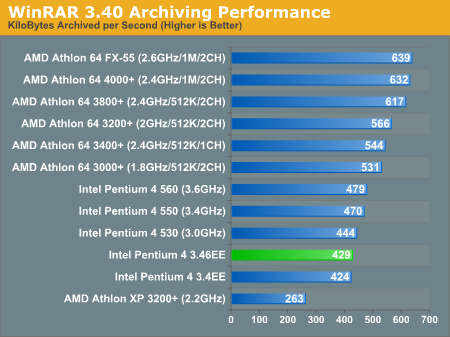










63 Comments
View All Comments
AlexWade - Sunday, October 31, 2004 - link
Now if only I can afford and find one ...MMORPGOD - Sunday, October 31, 2004 - link
IntelUser2000 - Sunday, October 31, 2004 - link
DDR2 is not a stupid move, its the speed they are at that's stupid. Remember DDR? They first ones ran at 200MHz, which were 50% faster than PC133 and still way faster than the enthusiast 166MHz SDRAMs. DDR's latency were higher, but since their clock is much higher, it wasn't a big problem as DDR2 vs DDR. However, PC1600 DDR still was not a big improvement over PC133, it was when PC2100 came that DDR started to shine.Another thing:
Quote:"With the original 925X chipset we were a bit unhappy to see that the Pentium 4's 800MHz FSB was paired with DDR2-533, creating one of those frustrating asynchronous situations."
I think 800MHz bus with DDR2-533 is actually VERY synchronous. First look it doesn't look like it. However since DDR2s latency is higher, it doesn't act like DDR533, it acts like DDR400. There was a Tomshardware review that was trying to predict the performance of 1066MHz bus.
First config was: 800MHz bus, DDR2-533
Second: 1066MHz bus, DDR2-533
Third: 1066MHz bus, DDR2-667
Guess which one had the biggest performance benefit? The third one, contrary to most people's belief. I think that tells that because of the DDR2's latency, you need DDR2-667 to perfectly match 1066MHz bus. Since Intel chose to stick with DDR2-533, they have created an asynchronous situation, making the performance not so much better. They should have went DDR2-667 with 1066MHz bus.
SLIM - Sunday, October 31, 2004 - link
One thing I didn't catch from anand's review is that the 3.46ee is rated at 110.7 watts according to [H]; just another reason to go AMD. Makes you wonder what the 3.73ee (which is supposed to launch this quarter) will have for a heatsink...Prometia for everyone:)
Tides - Sunday, October 31, 2004 - link
I remember reading a week or two ago about "AMD is going to have a tough time keeping up," from the lips of an Intel guy.Was this latest outing with the new P4EE's the proof? Perhaps I lack the foresight to understand what will happen in 6 months time, but in who's world is AMD going to have a hard time keeping up with? Cyrix's?
Tides - Sunday, October 31, 2004 - link
"ddr2 is a stupid move."Tides - Sunday, October 31, 2004 - link
not to mention, hi, ddr2 for is a stupid move. high latency, crap bandwidth, not just twice the price since you wouldn't have had to upgrade your ram otherwise if you already had solid ddr1.it reminds me of rambus. and beta max. and sony's discman. what else? ddr2 should have never come out imo. ddr3 is where it's at, hopefully amd will go straight to ddr3 and save it's customers and themselves the hastle of having to buy new ram, new mobos and so forth just to have to do it again with ddr3. i like faster everything as much as everyone else, but amd 64 proves ddr1 is alive and well, and ddr2 is what? exactly? perhaps in a year down the road, or two; it'll be worth something at the end of it's life cycle, just as ddr3 starts poking it's head about.
GhandiInstinct - Sunday, October 31, 2004 - link
Why don't they just screw any other core and focus on pumping out $1000 EEs? Everyones buying them, might as well. I really would like to know the stats for Intel's sales on their new cpus and chipsets, exact numbers.GhandiInstinct - Sunday, October 31, 2004 - link
#17 I was infering this world is off balance with that reality...Gnoad - Sunday, October 31, 2004 - link
wow. $1000 a pop for a CPU that gets destroyed by processors that cost a quarter as much. Totally asinine.